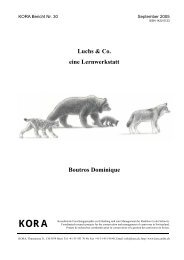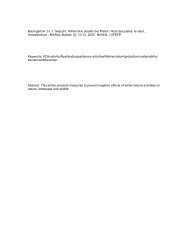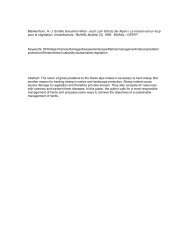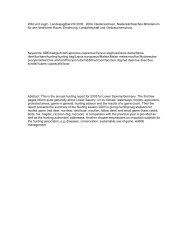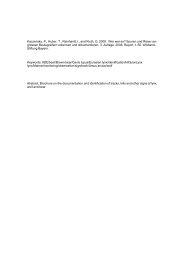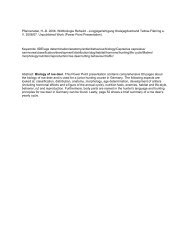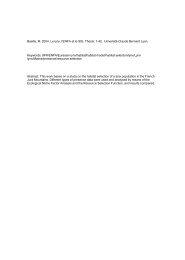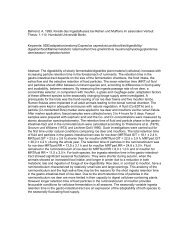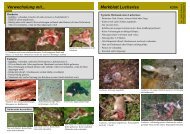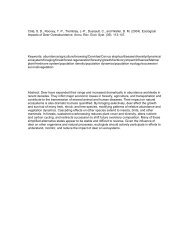You also want an ePaper? Increase the reach of your titles
YUMPU automatically turns print PDFs into web optimized ePapers that Google loves.
10 ResultsKORA <strong>Bericht</strong> Nr. 13was represented with 35% and type 2 and 3 with togetherwith 18.75%.The comparison between the re-introduced populationof Slovenia/Croatia and the population of theSwiss Alps showed a significant difference betweenthe different coat pattern types (df = 3, χ 2 = 20.29, P 0.1). The occurrences of the 4 coat patterntypes showed same ratios.3.3.1. Spatial distribution of coat patterns in SwitzerlandAnalyses of the spatial distribution in Switzerland resultedin a significant difference in the frequency of thefour coat pattern types between the Jura Mts populationand population of the Swiss Alps (df = 3, χ 2 = 24.35, P< 0.001). In the Jura Mts type 1 was dominant (77%)and type 4 were found in only 9 of 44 (20%) individuals.In the Swiss Alps the frequency showed the opposite:type 1 was found in 35% and type 4 in 59 of 128(46%) individuals (Figure 10). In the population of theSwiss Alps all of the five types (1, 2, 3, 4a, and 4b)were found. In the Jura Mts the coat pattern type withoutspots (type 3) is no longer present and the one withsmall spots (type 2) is very rare (2%).The range of the re-introduced population of theSwiss Alps is highly topographically structured. Toanalyse the spatial distribution of the different coat patterntypes, the range was divided into four regions(Figure 11). The occurrence of different types in theregion of Berne, Waadt, Fribourg (NWA) and Wallis(SA) showed no difference (df = 3, χ 2 = 1.59, P > 0.5).Between the Central Alps (CA) and NWA/SA the frequencyof coat patterns was just not significant (df = 3,χ 2 = 6.57, P > 0.05). A high significantly different frequencyof coat pattern types was found between thepopulation of the Swiss Alps and the Jura Mts population(df = 3, χ 2 = 27.2, P < 0.001).3.3.2. Temporal changes in pattern type frequenciesBefore 1908, in the historic population 15 of 21 (71%)individuals showed type 3 (without spots) and only 4(19%) type 1 (large spots). Type 4 did not exist. Reintroducedlynx (after 1972) were of completely differentpattern types than the historic individuals (SwissAlps, df = 3, χ 2 = 55, P < 0.001; Jura Mts, df = 3, χ 2 =45.6, P < 0.001). In the recent population of the SwissAlps 45 of 128 (35%) individuals showed type 1 andonly 10 (8%) type 3, moreover type 4 was found in 59of 128 (46%) individuals. The frequency of type 2 waslow in all populations (historical Alps: 2 of 21[9.5%],recent Alps: 14 of 128 [11%], Jura Mts: 1 of 44 [2%]).During the fist decade after the re-introduction thevariety of types increased, and after 20 years all fivetypes were present in the Swiss populations. To analysethis change more in detail frequencies were analyzedin 10 year intervals (1970-1979, 1980-1989 and1990-1999). In the late 70s type 1 had become rare andtype 3 had completely disappeared. During the 90s thefrequency of type 4 increased distinctly. These temporalchanges were only found in the population of theSwiss Alps. In the Jura Mts the database was too small.The temporal change correlated with the spatial distribution.The frequency of coat patterns in the 1970sshowed the distribution in Central Switzerland. Thedistribution in the North-west and South Alps reflectedthe 1990s.Figure 3. Principal-Component-Analyse. Everysymbol shows a single individual which is assortedafter the total number of spots and the existenceof rosettes. The first principal componentexplains 82.76 % of variance, the second 6.58 %.



